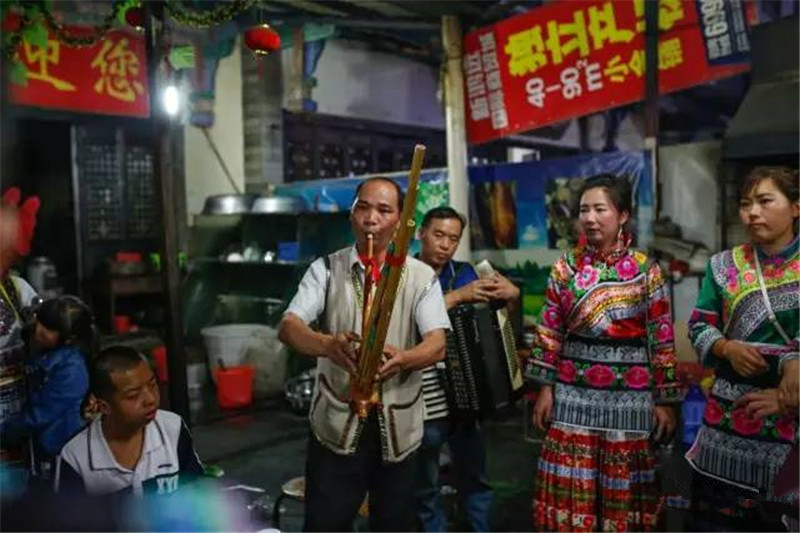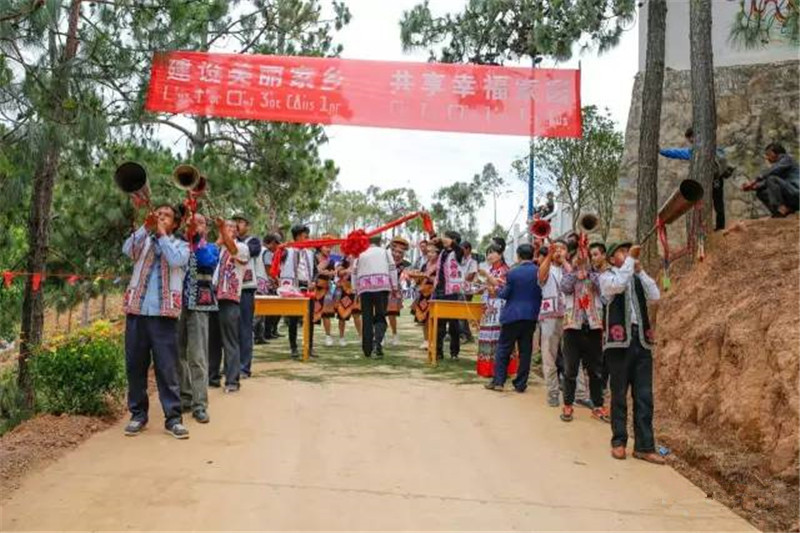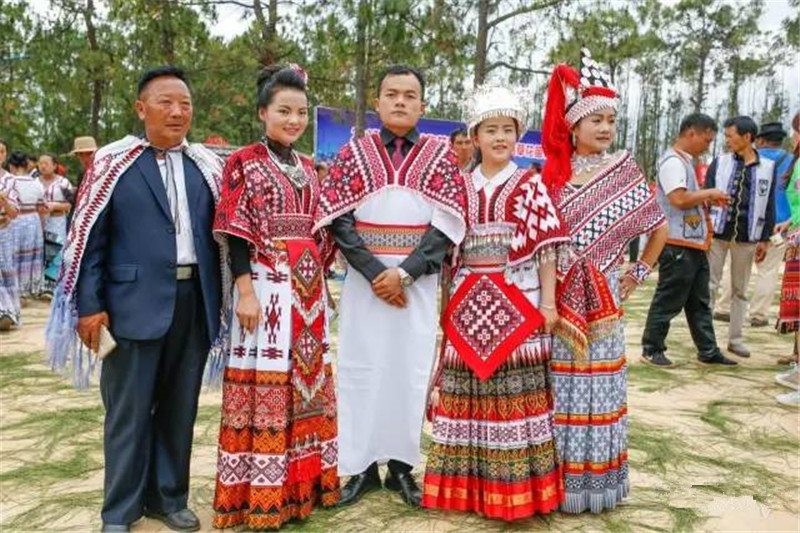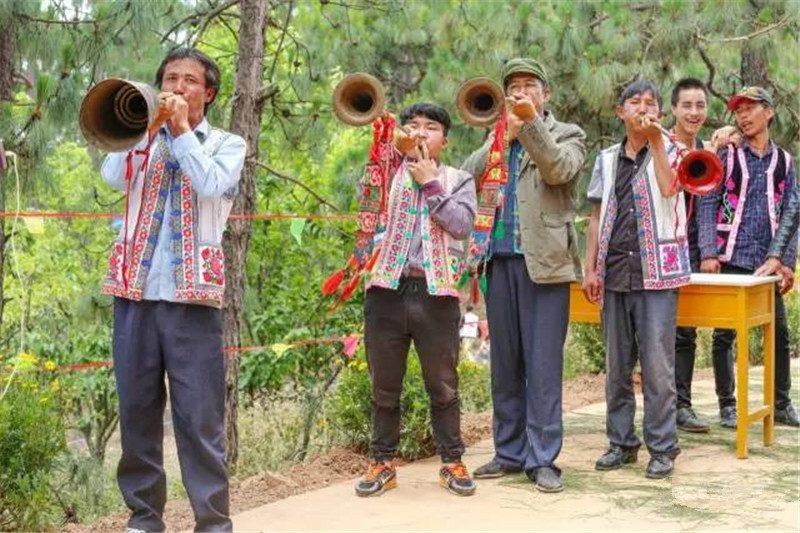
Huashan Festival of Miao Ethnic Minority in Chuxiong City, Chuxiong Prefecture
Overview of The Festival
- Chinese Name: 楚雄市紫溪镇白草花苗族村苗族花山节
- English Name: Huashan Festival of Miao Ethnic Minority in Chuxiong City, Chuxiong Prefecture
- Location:楚雄市紫溪镇白草花苗族村 Baicaohua Miao Ethnic Village of Zixi Town, Chuxiong City
- Festival Dates: From the 2nd to the 6th day of the first lunar month
The Huashan Festival, also known as “Tiaochang,” “Tiaohua,” “Shuahuasang,” and “Caihuashan,” is a festival that honors the ancient Miao ancestor, Chiyou. It typically takes place between the first and fifteenth days of the first lunar month. The main activities include climbing a flower pole, singing duets, jumping the lusheng (a type of musical instrument), practicing martial arts, and holding horse racing and bullfighting contests.

Historical Origin
The Miao ancestors’ tribe was invaded by foreign tribes. Under the leadership of their chief, Chiyou, the Miao people rose up to resist but were ultimately defeated due to being outnumbered and were forced to scatter. To gather his people, Miao chief Chiyou erected a flower pole on the mountain and instructed a musician to play the lusheng (a type of wind instrument). Upon hearing the familiar sound of the lusheng, the Miao people gathered from all directions beneath the flower pole and began their new life. Since then, the Miao people have held the “Huashan Festival” every year to commemorate their chief, Chiyou, and to celebrate the reconstruction of their new lives.

Background and Origin of The Festival
Huashan Festival, known as “A Yi Ao” in the Miao language, is held on the fifth day of the fifth lunar month each year. According to legend, the Miao people in Chuxiong, Yunnan, lived in a place called “ZhimiLi” during ancient times. The ancestors of the Miao people, such as the elder of the sun and the elder of the Ge Man, led their tribes to build cities. However, the people of the “Shanda Jue Di Ao” tribe came to seize their land, and both sides engaged in battle since the Chicken Year, Chicken Month, and Chicken Day, fighting for an unknown number of years. As the “Shanda Jue Di Ao” tribe grew in numbers, the city was besieged by their troops, leading to a blockade of water and food, and it seemed they would soon be breached.
In a moment of desperation, the Miao people devised a clever plan. They informed the enemy that it was their ancestral worship year, suggesting that they would not fight until after the rituals. Meanwhile, they vigorously prepared to break through and escape. Within the city, they erected two wooden poles; on one, they tied a large sheep, and on the other, a large goat. They placed a trough of food between them, and each animal had a copper drum placed in front of it. The animals, eager to grab the food, stomped and created a loud “dong dong” sound on the drums, causing the besieging enemies to think the people inside were preparing for battle and they nervously craned their necks to look.

The Miao people in the city were led by two leaders: one to organize the breakout and the other to protect the elderly and children during the escape. The sound of battle cries and the chaotic drumming confused the besieging enemies, leaving them unsure of how many Miao fighters were inside. Just as they were in panic, the breakout party cut through a path and escaped the siege, fleeing to safety.
The Miao people who escaped from their homeland deeply missed the cities and homes they had built, as well as the relatives who had died or been separated. They embroidered the rivers, fields, and city walls from their homeland onto their clothing. Additionally, they tied six small copper bells to the back of their outfits, resembling armor; whenever they moved, the bells rang continuously, serving as a reminder of their homeland and loved ones.
The Miao people chose the fifth day of the fifth lunar month to ascend the mountains together to look out over the land, slaughtering pigs and goats to honor the spirits of the deceased. This time of year coincides with the flourishing growth of all living things, with mountains and fields vibrant with wildflowers. The Miao people, inspired by the beautiful scenery, called it the “Huashan Festival,” which has continued to this day.

During the Huashan Festival in Chuxiong, Yunnan, Miao people from all directions don their meticulously crafted traditional attire to gather at the assembly grounds, playing the lusheng (a traditional reed instrument) and dancing the joyful lusheng dance. Men, women, and children pair off to compete in singing contests. Additionally, various sporting events beloved by the Miao people for centuries are held, including wearing flower clothes, bullfighting, horse racing, shooting, crossbow competitions, mountain climbing, basketball, tug-of-war, and the exchange of goods and materials.
Local Activities
- Traditional Dress Parade:
Participants dress in beautifully crafted traditional Miao clothing. The attire, often adorned with intricate embroidery and accessories, reflects the cultural heritage and identity of the Miao people. A parade showcases these stunning outfits, celebrating both individuality and community. - Lusheng Dance and Music:
The lusheng, a traditional reed instrument, is played throughout the festival, setting a lively atmosphere. Miao people perform traditional dances, often accompanied by lusheng music, creating a joyful and festive environment. The lusheng dance, characterized by vibrant movements, allows both young and old to participate and celebrate together. - Singing Contests:
Singing competitions are an integral part of the festival, where individuals or teams engage in traditional folk singing. This competition not only highlights the participants’ vocal talents but also serves as a way to express emotions, stories, and cultural narratives through music. - Sports Competitions:
Various sporting events take place during the festival, including:- Bullfighting: A traditional activity that brings excitement to the festival, showcasing strength and skill.
- Horse Racing: Competitors race on horseback, reflecting the swift agility of both horses and riders.
- Shooting and Crossbow Competitions: These competitions demonstrate marksmanship and are a nod to the historical hunting practices of the Miao.
- Basketball and Tug-of-War: Modern sports are included to engage a wider range of participants and encourage camaraderie among community members.
- Food Festivals:
The festival features a variety of traditional Miao foods, including rice, meats, and local dishes. Visitors and participants can enjoy communal dining experiences, fostering a sense of community. - Cultural Performances:
Folk performances, including traditional dances, story-telling, and theatrical displays, are held to educate and entertain attendees about the Miao people’s history and culture. - Honoring Ancestors:
A solemn part of the festival includes rituals to honor ancestors, often involving offerings and prayers. This reflects the Miao people’s deep respect for their heritage and the importance of family and community ties. - Crafts and Market Exchange:
Local artisans display and sell handmade crafts, textiles, and traditional goods. This market becomes a hub for cultural exchange and economic interaction within the community. - Mountain Climbing and Nature Activities:
Given the festival’s connection to nature, some participants engage in mountain climbing or other outdoor activities, celebrating the beauty of the landscape and the changing seasons.

 7 Days GolfingTour
7 Days GolfingTour
 8 Days Group Tour
8 Days Group Tour
 8 Days Yunnan Tour
8 Days Yunnan Tour
 7 Days Shangri La Hiking
7 Days Shangri La Hiking
 11 Days Yunnan Tour
11 Days Yunnan Tour
 6 Days Yuanyang Terraces
6 Days Yuanyang Terraces
 11 Days Yunnan Tour
11 Days Yunnan Tour
 8 Days South Yunnan
8 Days South Yunnan
 7 Days Tea Tour
7 Days Tea Tour
 8 Days Muslim Tour
8 Days Muslim Tour
 12 Days Self-Driving
12 Days Self-Driving
 4 Days Haba Climbing
4 Days Haba Climbing
 Tiger Leaping Gorge
Tiger Leaping Gorge
 Stone Forest
Stone Forest
 Yunnan-Tibet
Yunnan-Tibet
 Hani Rice Terraces
Hani Rice Terraces
 Kunming
Kunming
 Lijiang
Lijiang
 Shangri-la
Shangri-la
 Dali
Dali
 XishuangBanna
XishuangBanna
 Honghe
Honghe
 Kunming
Kunming
 Lijiang
Lijiang
 Shangri-la
Shangri-la
 Yuanyang Rice Terraces
Yuanyang Rice Terraces
 Nujiang
Nujiang
 XishuangBanna
XishuangBanna
 Spring City Golf
Spring City Golf
 Snow Mountain Golf
Snow Mountain Golf
 Stone Mountain Golf
Stone Mountain Golf

















